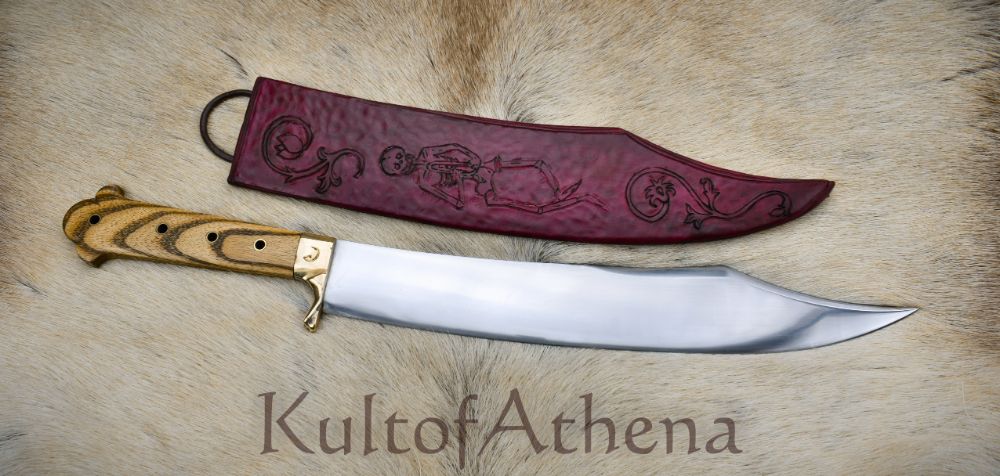This large custom-crafted Bauernwehr has an agreeable and deadly balance to it – it is immediately clear when held that this dagger is as attractive, as it is a responsive and deadly. Both its brass bolster and wooden grip are lovingly well crafted by hand and a close inspection will show the tell-tale marks made by artisanal craftsmanship which give the piece some great unique character. As if that wasn’t character enough, the bold-hued wood-core cabbard with a hand-inscribed macabre Totentanz scene crafted by András Mezősi surely does the trick! Included is a signed Certificate from bladesmith and artisan Ádám Bodorics which details his though process when creating this piece. Read on to see his thoughts for this dagger in his own words:
The Bauernwehr is a (generally) dagger-sized sidearm with a hilt construction similar to table and utility knifes of the same period. They are in fashion for most of the 15th century, and are still well-present in the 16th century as well. Hunting sets with a main piece hilted in the same way are known as trousses, and in that form, the core concept survives to at least the 18th century.
I made two rather similar Bauernwehrs at the same time. In both cases, the idea was to create unique, preferably unprecedented pieces that still wouldn’t stand out if they were included in a period illustration. In the specific case of the pagoda wood one, I wanted it to be a hard-hitting sidearm with a massive blade presence, while not making it cumbersome or overweight.
To achieve this goal, the blade has a convex cross-section for the entire length, with a fullered partial tang and a grip as thin as I dared to make it without risking structural issues. This fantasy piece combines design elements from a variety of sources. The trilobate end of the grip is shown by some illustrators, most prominently by Hans Sebald Beham in the first half of the 16th century on sword-sized sidearms including Messers and at least one proto-Katzbalger.
The shape of the bolsters and the lack of a protruding Nagel is based on a few pieces by Hans Sumersperger. The blade shape is inspired by some possibly exaggerated illustrations from the 15th-16th centuries. The partial hidden tang construction is used on both late Messers and early sabers. The only truly ahistorical details would be the pagoda wood grip, and obviously, the combination of all these elements into one package.
The 305mm long blade is hand-ground from 51cvr4/6150 steel. It’s hand-sanded to a near-mirror finish with some tool marks visible underneath as seen on multiple original metal objects. While it has a falseedge that extends beyond the clip itself, due to the cross-section this edge is less capable of slicing. The scabbard is constructed from thin wood following the cross-section of the blade as close as we could get it. It’s bound in linen and wrapped in leather to make it as thin as possible. It’s decorated with floral and Totentanz motifs with a heavily textured background, and is dyed oxblood. The leather wrap is sewn shut on the back, and a pair of channels are formed out of the leather itself for a leather cord to be thread through for vertical carry on a belt. – Ádám Bodorics












Reviews
There are no reviews yet.